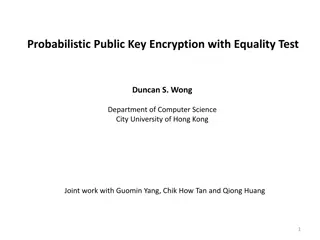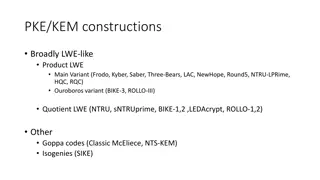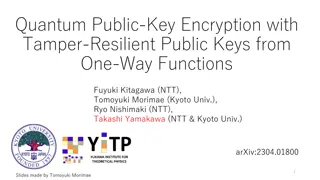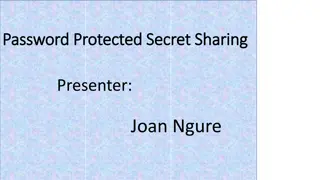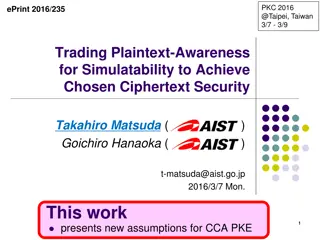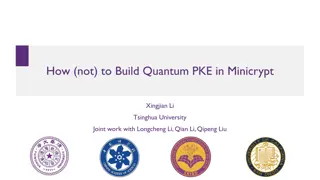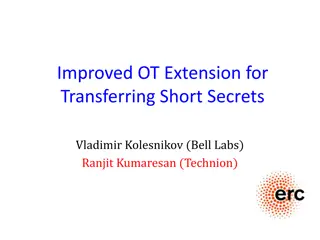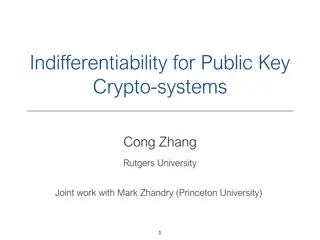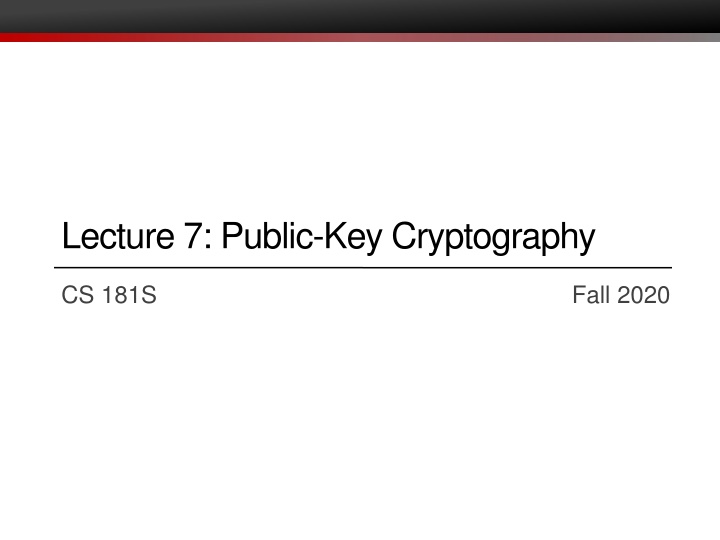
Public Key Cryptography: Fundamentals and RSA Encryption
Learn about public-key cryptography, key pairs, encryption algorithms, and the RSA encryption scheme. Explore how RSA works through examples and theorems, and understand its significance in secure communication.
Download Presentation

Please find below an Image/Link to download the presentation.
The content on the website is provided AS IS for your information and personal use only. It may not be sold, licensed, or shared on other websites without obtaining consent from the author. If you encounter any issues during the download, it is possible that the publisher has removed the file from their server.
You are allowed to download the files provided on this website for personal or commercial use, subject to the condition that they are used lawfully. All files are the property of their respective owners.
The content on the website is provided AS IS for your information and personal use only. It may not be sold, licensed, or shared on other websites without obtaining consent from the author.
E N D
Presentation Transcript
Lecture 7: Public-Key Cryptography CS 181S Fall 2020
Key pairs Instead of sharing a key between pairs of principals... ...every principal has a pair of keys public key: published for the world to see private key: kept secret and never shared
(Public-Key) Encryption algorithms Gen(1?): generate a keypair (pk, sk) of length n Enc(?;??): encrypt message under public key pk Dec ?;?? : decrypt ciphertext c with secret key sk Enc Dec Gen,Enc,Dec is a public-key encryption scheme aka cryptosystem
RSA [Rivest, Shamir, Adleman 1977] Shared Turing Award in 2002: ingenious contribution to making public-key crypto Gen(len): Pick primes ?,?, define ? = ? ? Choose ?,? such that ?? = 1 mod (? 1)(? 1) ?? = ?,? , ?? = (?,?,?) Enc(m, pk) ? = ?? mod ? Dec(c, sk): ? = ?? mod ?
Exercise 1: RSA Let ?? = ?,? = (21,5) and ?? = ?,?,? = (3,7,5) Observe that ?? = 5 5 = 25 = 1 mod 12 1. Compute ? = Enc(17;??) = 175 mod 21 = 1419857 mod 21 = 5 ? = Enc 17; 21,5 2. Compute Dec(?;??) = 55 mod 21 = 3125 mod 21 = 17 Dec ?;?? = Dec 5; 3,7,5
RSA Theorem: RSA is a correct public-key encryption scheme. Theorem: ?? mod ??? mod ?? == ? ?? mod ??? mod ?? Dec Enc ?;?? ;?? = ?? ? mod ?? = = ??? mod ?? = ? mod ?? ??? mod ? = ?1+?(? 1)(? 1) mod ? ??? mod ? = ?1+?(? 1)(? 1) mod ? = ? (?? 1) ?(? 1) mod ? = ? (?? 1) ?(? 1) mod ? = ? (?? 1 mod ?) ?(? 1) mod ? = ? (?? 1 mod ?) ?(? 1) mod ? = ? 1 ? ? 1 mod ? = ? 1 ? ? 1 mod ? = ? mod ? = ? mod ?
RSA Theorem: RSA is a secure public-key encryption scheme. Rabin Encryption (integer factorization) ElGamal Encryption (discrete log) Pailler Encryption (composite residuosity) Elliptic Curve Integrated Encryption Scheme (comp. DH)
Problems with Textbook RSA Deterministic: given same plaintext and key, always produces the same ciphertext Small numbers: if m^e < n, then log is easy to compute Big numbers: if m > n, can't compute do math mod n Side channel attacks: interfaces can leak information about secret key Key Management: no secure place to store the secret key Quantum Computers: provably breakable with different hardware
Solution 1: Padding PKCS#1 v1.5: 0x00 0x02 [non-zero bytes] 0x00 [message] Vulnerable to a padding oracle attack! OAEP (Optimal Asymmetric Encryption Padding) Security proof (with assumptions)
Exercise 2: OAEP Define a function to compute m given values X and Y, constants k0 and k1, and hash functions G and H
Exercise 2: OAEP Define a function to compute m given values X and Y, constants k0 and k1, and hash functions G and H extract_m(X, Y){ r = H(X)^Y; m' = X^G(r); m = m' >> k1; return m; }
Problems with Textbook RSA Deterministic: given same plaintext and key, always produces the same ciphertext Small numbers: if m^e < n, then log is easy to compute Big numbers: if m > n, can't compute do math mod n Side channel attacks: interfaces can leak information about secret key Key Management: no secure place to store the secret key Quantum Computers: provably breakable with different hardware
Solution 2: Hybrid encryption Assume: Symmetric encryption scheme (Gen_SE, Enc_SE, Dec_SE) Public-key encryption scheme (Gen_PKE, Enc_PKE, Dec_PKE) Use public-key encryption to establish a shared session key Avoids quadratic problem, assuming existence of phonebook Avoids problem of key distribution Use symmetric encryption to exchange long plaintext encrypted under session key Gain efficiency of block cipher and mode
Protocol to exchange encrypted message m 0. B: (pk_B, sk_B) = Gen_PKE(len_PKE) publish (B, pk_B) 1. A: k_s = Gen_SE(len_SE) c1 = Enc_PKE(k_s; pk_B) c2 = Enc_SE(m; k_s) 2. A -> B: c1, c2 3. B: k_s = Dec_PKE(c1; sk_B) m = Dec_SE(c2; k_s)
Session keys If key compromised, only those messages encrypted under it are disclosed Used for a brief period then discarded cryptoperiod: length of time for which key is valid in this case, for a single (long) message not intended for reuse in future messages only intended for unidirectional usage: A->B, not B->A
Problems with Textbook RSA Deterministic: given same plaintext and key, always produces the same ciphertext Small numbers: if m^e < n, then log is easy to compute Big numbers: if m > n, can't compute do math mod n Side channel attacks: interfaces can leak information about secret key Key Management: no secure place to store the secret key Quantum Computers: provably breakable with different hardware
Square-and-Multiply int modular_exp(x, n, p){ res = 1; while (n > 0) { if (n % 2 == 1){ res = res * x % p; } x = x^2 % p; n >> 1; } return res; }
Exercise 3: Square-and Multiply Compute 35 mod 21 using square and multiply int modular_exp(x, n, p){ res = 1; while (n > 0) { if (n % 2 == 1){ res = res * x % p; } x = x^2 % p; n >> 1; } return res; } res = 1 x = 3 n = 5 res = 3 x = 9 n = 2 res = 3 x = 18 n = 1 res = 12 x = 9 n = 0
Side Channels Power Timing EM Radiation Acoustics
Solution 3: Blinded RSA [Rivest, Shamir, Adleman 1977] Shared Turing Award in 2002: ingenious contribution to making public-key crypto Gen(len): Pick primes ?,? Choose ?,? such that ?? = 1 mod lcm(? 1,? 1) ?? = ?,? , ?? = (?,?,?) Enc(m, pk) ? = ?? mod ? Dec(c, sk): ? = ((??)? mod ?) ? ?
Problems with Textbook RSA Deterministic: given same plaintext and key, always produces the same ciphertext Small numbers: if m^e < n, then log is easy to compute Big numbers: if m > n, can't compute do math mod n Side channel attacks: interfaces can leak information about secret key Key Management: no secure place to store the secret key Quantum Computers: provably breakable with different hardware
Solution 4: Key Management Store keys offline Store keys in protected files Memorize the keys (sort of)
Password-Based Encryption PBKDF2: Password-based key derivation function [RFC 8018] Output: derived key k Input: Password p Salt s Iteration count c Key length len Pseudorandom function (PRF): "looks random" to an adversary that doesn't know an input called the seed (commony instantiated with an HMAC)
PBKDF2 Algorithm: F(p, s, i, c) = U(1) XOR ... XOR U(c) U(1) = PRF(s, i; p) U(j) = PRF(U(j-1); p) F is in essence a salted iterated hash... k = F(p, s, 1, c) || F(p, s, 2, c) || ... || F(p, s, n, c) enough copies to reach keylen || denotes bit concatenation
Problems with Textbook RSA Deterministic: given same plaintext and key, always produces the same ciphertext Small numbers: if m^e < n, then log is easy to compute Big numbers: if m > n, can't compute do math mod n Side channel attacks: interfaces can leak information about secret key Key Management: no secure place to store the secret key Quantum Computers: provably breakable with different hardware
28 Exercise 4: Feedback Rate how well you think this recorded lecture worked Better than an in-person class About as well as an in-person class Less well than an in-person class, but you still learned something Total waste of time, you didn't learn anything 1. 1. 2. 3. 4. How much time did you spend on this video lecture (including time spent on exercises)? 2. Do you have particular questions you would like me to address in this week's problem session? 3. Would you prefer to keep using this asynchronous/flipped classroom approach or would you prefer to switch to synchronous teaching? 4. Do you have any other comments or feedback? 5.

